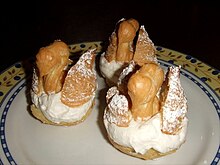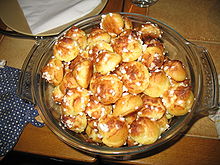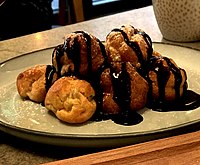| Revision as of 12:58, 5 October 2023 view sourceMacrakis (talk | contribs)Autopatrolled, Extended confirmed users, Pending changes reviewers, Rollbackers53,863 edits typoTag: 2017 wikitext editor← Previous edit | Revision as of 13:03, 5 October 2023 view source Macrakis (talk | contribs)Autopatrolled, Extended confirmed users, Pending changes reviewers, Rollbackers53,863 edits reorganizeTag: Visual editNext edit → | ||
| Line 21: | Line 21: | ||
| ==History== | ==History== | ||
| The term "choux" has two meanings in the early literature. One is a kind of cheese puff, first documented in the 13th century; the other corresponds to the modern choux pastry and is documented in English, German, and French cookbooks in the 16th century.<ref name="potter">{{Cite journal |last=Potter |first=David |date=July 2003 |title=Powches, Puffs and Profiteroles: Early Choux Paste Receipts |url=https://prospectbooks.co.uk/products-page/ppc/ppc-073-july-2003-pdf-only/ |journal=] |volume=73 |pages=25-40}}</ref> This dough was sometimes baked, sometimes fried. Choux pastry is later widely documented in the 18th century, under names including Pate a la Royale or Paste Royal.<ref name="potter" /> | |||
| ⚫ | Popelins were common aristocratic desserts in the 16th century, and were flavored with cheese or citrus (for example lemon peel, orange blossom water, etc.).<ref>{{cite web |access-date=5 Jan 2021 |url=https://www.parisunlocked.com/food/food-history/french-choux-pastry-a-short-history/#A_Bit_of_History |title=French Choux Pastry: A Short History |date=29 Jul 2021 |first=Courtney |last=Traub |website=Paris Unlocked}}</ref> They were prepared from dough that had been dried over a fire to evaporate its water, which was called {{lang|fr|pâte à chaud}} (literally meaning 'hot pastry').<ref>S.G. Sender, Marcel Derrien, ''La Grande Histoire de la pâtisserie-confiserie française'', Minerva, 2003 {{ISBN|2-8307-0725-7}}, {{p.|98}}.</ref> | ||
| The term "choux" has two meanings in the early literature. One is a kind of cheese puff, first documented in the 13th century; the other corresponds to the modern choux pastry and is documented in English, German, and French cookbooks in the 16th century.<ref name="potter" /> This dough was sometimes baked, sometimes fried. Choux pastry is later widely documented in the 18th century, under names including Pate a la Royale or Paste Royal.<ref name="potter" /> | |||
| ⚫ | The royal chefs Jean Avice, a {{lang|fr|]|italic=no}}, and {{lang|fr|]|italic=no}}, who worked in the court of ], made modifications to the recipe in the 18th century, resulting in the recipe most commonly used now for ].<ref>{{cite book |last=Juillet |first=Claude |title=Classic Patisserie: An A–Z Handbook |publisher=Butterworth-Heinemann |year=1998 |isbn=0-7506-3815-X}}</ref> | ||
| ⚫ | |||
| ⚫ | A widely repeated story claims that choux pastry was invented in 1540 by a Pantanelli and a Popelini (neither of whom is ever cited with a first name), supposedly the pastry chefs of ], the Italian wife of ].<ref>{{cite book |title=Le Cordon Bleu patisserie foundations |date=2 December 2011 |publisher=Delmar |isbn=978-1-4390-5713-1 |location=Clifton Park, New York}}</ref> This is part of ] that Italian cuisine was introduced to France by her retinue,<ref name="potter" /><ref>{{Cite book |last=David |first=Elizabeth |url=https://books.google.com/books?id=KWGtAAAAQBAJ&newbks=0&printsec=frontcover&pg=PT10&dq=imagination+of+one+or+the+popular+historical+novelists+elizabeth+david&hl=en |title=Italian Food |date=1987 |publisher=Penguin Books Limited |isbn=978-1-4059-1737-7 |language=en}}</ref> apparently first mentioned in the 18th century.<ref name="Wheaton2011" /><ref>{{cite book |last1=Diderot |first1=Denis |title=Encyclopédie, ou dictionnaire raisonné des sciences, des arts et des métiers |last2=le Rond d'Alembert |first2=Jean |date=1754 |publisher=Briasson, David, Le Breton and Durand |location=Paris |page=vol. IV, p. 538}}</ref> Pantenelli supposedly invented the dough in 1540,<ref>{{cite web |last=Broder |first=Jaye |date=19 Jan 2014 |title=Pâte À Choux |url=https://sites.psu.edu/doughries/2014/01/19/choux/https://sites.psu.edu/doughries/2014/01/19/choux/ |access-date=5 Jan 2022 |website=Doughries}}</ref> seven years after the arrival of Catherine in France. He is said to have used the dough to make a ] named it {{lang|fr|pâte à Pantanelli}}. Over time, the recipe of the dough evolved, and the name changed to {{lang|fr|pâte à popelin}}, which was used to make {{lang|fr|popelins}}, named after Pantanelli's successor Popelini. However, the story of Popelini, also called Popelin, only appears in the beginning of the 1890s in the writings of Pierre Lacam,<ref name=":0">Bienassis, Loïc; Campanini, Antonella (6 December 2022), Brioist, Pascal; Quellier, Florent (eds.), "La reine à la fourchette et autres histoires. Ce que la table française emprunta à l'Italie : analyse critique d'un mythe", La table de la Renaissance : Le mythe italien, Tables des hommes (in French), Tours: Presses universitaires François-Rabelais, pp. 29–88, <nowiki>ISBN 978-2-86906-842-1</nowiki>, retrieved 5 October 2023</ref><ref>{{Cite book |last=Lacam |first=Pierre |url=https://books.google.com/books?id=D2A0QwAACAAJ&newbks=0&hl=en |title=Le Glacier classique et artistique en France et en Italie |last2=Charabot |first2=Antoine |date=1893 |publisher=Hachette |year= |isbn=2329610289 |edition=2021 reprint |language=fr}}</ref> with the name probably being created starting from the existing recipe for ''popelins''; similarly, Pantarelli appears to be derived from ''pâte''.<ref name=":0" /> The story appears to be entirely fictional. | ||
| ⚫ | Popelins were common aristocratic desserts in the 16th century, and were flavored with cheese or citrus (for example lemon peel, orange blossom water, etc.).<ref>{{cite web |access-date=5 Jan 2021 |url=https://www.parisunlocked.com/food/food-history/french-choux-pastry-a-short-history/#A_Bit_of_History |title=French Choux Pastry: A Short History |date=29 Jul 2021 |first=Courtney |last=Traub |website=Paris Unlocked}}</ref> They were prepared from dough that had been dried over a fire to evaporate its water, which was called {{lang|fr|pâte à chaud}} (literally meaning 'hot pastry').<ref>S.G. Sender, Marcel Derrien, ''La Grande Histoire de la pâtisserie-confiserie française'', Minerva, 2003 {{ISBN|2-8307-0725-7}}, {{p.|98}}.</ref> |
||
| ⚫ | The royal chefs Jean Avice, a {{lang|fr|]|italic=no}}, and {{lang|fr|]|italic=no}}, who worked in the court of ], made modifications to the recipe in the 18th century, resulting in the recipe most commonly used now for ].<ref>{{cite book |last=Juillet |first=Claude |title=Classic Patisserie: An A–Z Handbook |
||
| ==Essential ingredients and manner of rising== | ==Essential ingredients and manner of rising== | ||
Revision as of 13:03, 5 October 2023
Type of pastry dough Choux pastry swans Choux pastry swans | |
| Alternative names | Pâte à choux |
|---|---|
| Type | Pastry |
| Place of origin | France; Italy |
| Region or state | Paris |
| Main ingredients | Butter, flour, eggs, water |
Choux pastry, or pâte à choux (Template:IPA-fr), is a delicate pastry dough used in many pastries. Basic ingredients usually only include butter, water, flour and eggs (auxiliary ingredients and flavorings are also added).
Instead of a raising agent, choux pastry employs its high moisture content to create steam, as the water in the dough evaporates when baked, puffing the pastry. The pastry is used in many European cuisines, including French cuisine and Spanish cuisine, and is the basis of many notable desserts, including profiteroles, éclairs and churros.
History
The term "choux" has two meanings in the early literature. One is a kind of cheese puff, first documented in the 13th century; the other corresponds to the modern choux pastry and is documented in English, German, and French cookbooks in the 16th century. This dough was sometimes baked, sometimes fried. Choux pastry is later widely documented in the 18th century, under names including Pate a la Royale or Paste Royal.
Popelins were common aristocratic desserts in the 16th century, and were flavored with cheese or citrus (for example lemon peel, orange blossom water, etc.). They were prepared from dough that had been dried over a fire to evaporate its water, which was called pâte à chaud (literally meaning 'hot pastry').
The royal chefs Jean Avice, a pâtissier, and Antoine Carême, who worked in the court of Marie Antoinette, made modifications to the recipe in the 18th century, resulting in the recipe most commonly used now for profiteroles.
A widely repeated story claims that choux pastry was invented in 1540 by a Pantanelli and a Popelini (neither of whom is ever cited with a first name), supposedly the pastry chefs of Queen Catherine de' Medici, the Italian wife of King Henry II of France. This is part of the fiction that Italian cuisine was introduced to France by her retinue, apparently first mentioned in the 18th century. Pantenelli supposedly invented the dough in 1540, seven years after the arrival of Catherine in France. He is said to have used the dough to make a gâteau named it pâte à Pantanelli. Over time, the recipe of the dough evolved, and the name changed to pâte à popelin, which was used to make popelins, named after Pantanelli's successor Popelini. However, the story of Popelini, also called Popelin, only appears in the beginning of the 1890s in the writings of Pierre Lacam, with the name probably being created starting from the existing recipe for popelins; similarly, Pantarelli appears to be derived from pâte. The story appears to be entirely fictional.
Essential ingredients and manner of rising
The ingredients for choux pastry are butter, water, flour and eggs. Like Yorkshire pudding or David Eyre's pancake, instead of a raising agent, it employs high moisture content to create steam during cooking to puff the pastry. The high moisture content is achieved by boiling the water and butter, then adding the flour. The mixture is cooked a few minutes longer, then cooled before adding enough eggs to achieve the desired consistency. The boiling step causes the starch in the flour to gel, allowing the incorporation of more water.
Foods made with choux pastry
Main article: List of choux pastry dishesThis pastry is used to make choux (small puffs), as the name implies, but also profiteroles, croquembouches, éclairs, religieuses, French crullers, beignets, St. Honoré cake, Parisian gnocchi, dumplings, chouquettes (unfilled choux pastry paired with pearl sugar) and gougères.
Choux pastry is usually baked, but for beignets, it is fried. In Spain and Latin America, churros are made of fried choux pastry, sugared and dipped in a thick hot chocolate for breakfast. In Italian cuisine, choux pastry is the base for zeppole di San Giuseppe which are cream-filled pastries eaten on March 19 for the feast of Saint Joseph. In Austrian cuisine, one variation of Marillenknödel, a sweet apricot dumpling cooked in simmering water, uses choux pastry; in that case it does not puff, but remains relatively dense. Choux pastries are sometimes filled with cream after baking to make cream puffs or éclairs.
A craquelin is covered in a "crackly" sugar topping — and often filled with pastry cream, much like an éclair.
Chouquette

A chouquette (Template:IPA-fr), a diminutive of choux, is a small, round, hollow choux pastry covered with pearl sugar. Unlike éclairs which are also made with choux pastry, chouquettes are bite-sized and the hollow inside is not filled.
Chouquettes originate from Paris, and can be enjoyed at anytime of the day, typically for breakfast or as an afternoon snack.
Gallery
-
Mixing choux pastry dough for beignets
-
Piping out the dough for beignets with a pastry bag
-
 Classic Profiteroles serving, with chocolate sauce
Classic Profiteroles serving, with chocolate sauce
See also
References
- ^ Potter, David (July 2003). "Powches, Puffs and Profiteroles: Early Choux Paste Receipts". Petits Propos Culinaires. 73: 25–40.
- Traub, Courtney (29 July 2021). "French Choux Pastry: A Short History". Paris Unlocked. Retrieved 5 January 2021.
- S.G. Sender, Marcel Derrien, La Grande Histoire de la pâtisserie-confiserie française, Minerva, 2003 ISBN 2-8307-0725-7, p. 98.
- Juillet, Claude (1998). Classic Patisserie: An A–Z Handbook. Butterworth-Heinemann. ISBN 0-7506-3815-X.
- Le Cordon Bleu patisserie foundations. Clifton Park, New York: Delmar. 2 December 2011. ISBN 978-1-4390-5713-1.
- David, Elizabeth (1987). Italian Food. Penguin Books Limited. ISBN 978-1-4059-1737-7.
- Cite error: The named reference
Wheaton2011was invoked but never defined (see the help page). - Diderot, Denis; le Rond d'Alembert, Jean (1754). Encyclopédie, ou dictionnaire raisonné des sciences, des arts et des métiers. Paris: Briasson, David, Le Breton and Durand. p. vol. IV, p. 538.
- Broder, Jaye (19 January 2014). "Pâte À Choux". Doughries. Retrieved 5 January 2022.
- ^ Bienassis, Loïc; Campanini, Antonella (6 December 2022), Brioist, Pascal; Quellier, Florent (eds.), "La reine à la fourchette et autres histoires. Ce que la table française emprunta à l'Italie : analyse critique d'un mythe", La table de la Renaissance : Le mythe italien, Tables des hommes (in French), Tours: Presses universitaires François-Rabelais, pp. 29–88, ISBN 978-2-86906-842-1, retrieved 5 October 2023
- Lacam, Pierre; Charabot, Antoine (1893). Le Glacier classique et artistique en France et en Italie (in French) (2021 reprint ed.). Hachette. ISBN 2329610289.
- McGee, Harold (2004). On Food and Cooking: The Science and Lore of the Kitchen (Completely rev. and updated. ed.). New York, New York: Scribner. pp. 552–553, 612. ISBN 0-684-80001-2.
- Pellaprat, Henri-Paul; Tower, Jeremiah (2012). The Great Book of French Cuisine. Vendome Press. ISBN 9780865652798.
- cite web |last1=David |first1=Lebovitz |url=https://www.davidlebovitz.com/les-chouquettes/ |access-date=24 October 2021 |language=en
- "Recipe for this variation of Marillenknödel". GuteKueche.at (in German).
- "Basics: Choux pastry". Just Hungry. 6 April 2004. Retrieved 8 September 2010.
- "Illustrated recipes, kitchenware shop, kitchen accessories, professional cookware on Meilleur du Chef". Cuisine-french.com. Retrieved 1 May 2012.
- Harlé, Eva (18 March 2015). Pains et Viennoiseries (in French). Hachette Pratique. p. 138. ISBN 9782014600407. Retrieved 1 October 2016.
- Rose, Lucie (12 January 2015). "Meet the Chouquette: Parisian Breakfast at its Finest". Frenchly. Retrieved 29 March 2021.
External links
Categories: